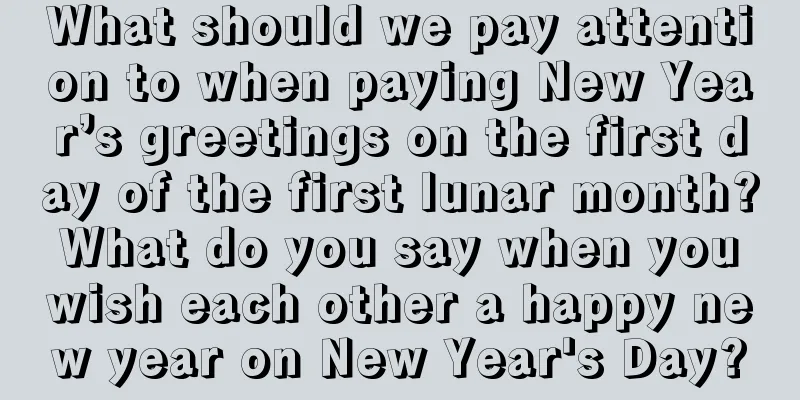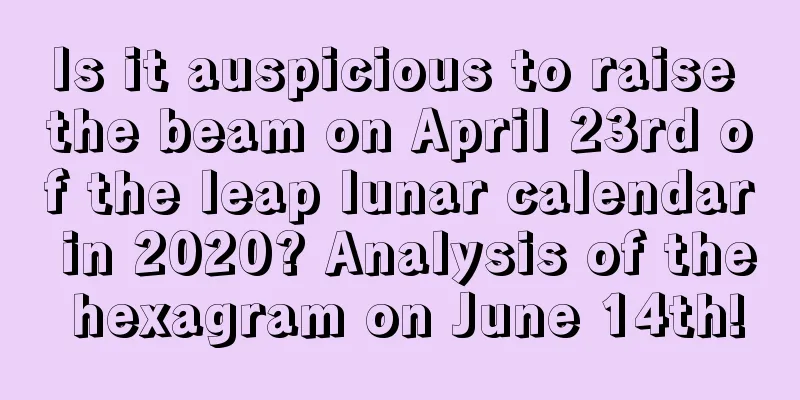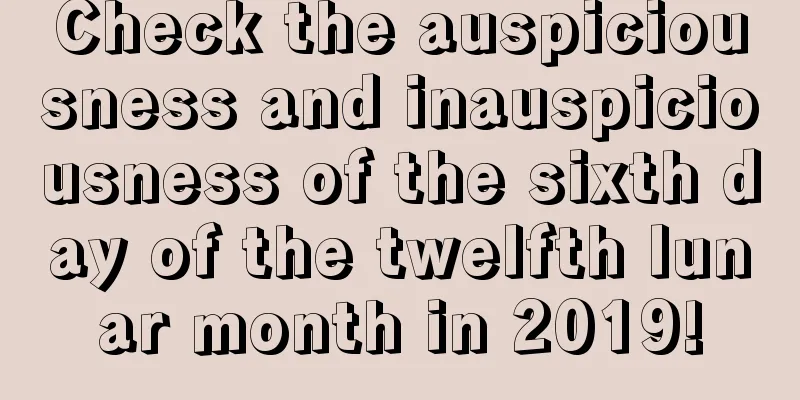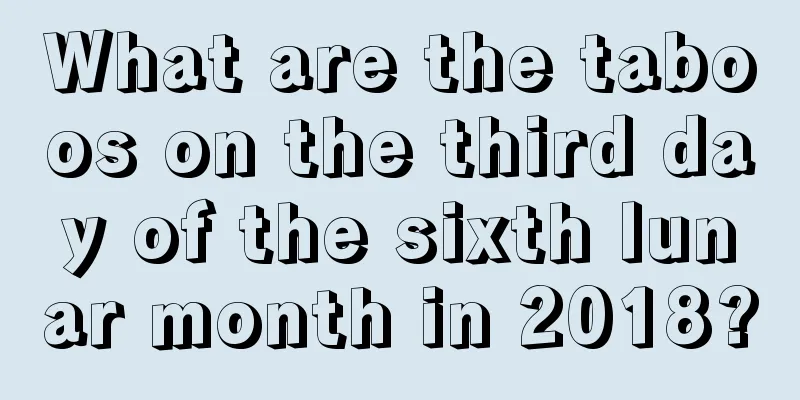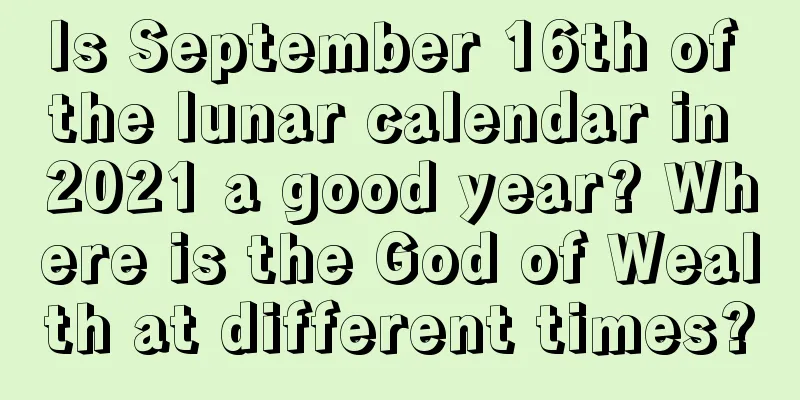Can we worship our ancestors during the Spring Equinox? What are the etiquette and taboos of ancestor worship during the Spring Equinox?

Introduction: Ancestor worship, as the name suggests, means offering sacrifices to ancestors to express one's longing for them. We Chinese have a tradition of respecting the dead and remembering our ancestors. We never forget to worship our ancestors during festivals. So, can we worship our ancestors on the fourth solar term of the 24 solar terms, the Spring Equinox? What are the etiquette and taboos of ancestor worship during the Spring Equinox? Let’s take a look together! Mr. Shui Mo summarized many festivals and solar terms in the second month of the lunar calendar to help people better understand how to face every day in February.Spring Equinox - Memorial DayThe Spring Equinox Festival originated in the Zhou Dynasty. "The Book of Rites" says: "Sacrifice the sun on the altar." Kong Yingda's commentary says: "It refers to the Spring Equinox." Therefore, this custom was passed down. Pan Rongbi of the Qing Dynasty wrote in The Chronicle of the Capital's Sui Shi Sheng: "Sacrifices to the sun on the Spring Equinox and to the moon on the Autumn Equinox are grand national ceremonies, and scholars and common people are not allowed to offer sacrifices on their own."Although the memorial day is not as grand as the ceremonies of offering sacrifices to heaven and earth, its rituals are also quite grand. When the emperors of the Ming Dynasty celebrated their deaths, they would use jade and silk as offerings, make three offerings, play seven pieces of music, perform eight kinds of dance, and perform the ritual of three kneelings and nine bows. The Qing Dynasty emperors' memorial day rituals included nine items: welcoming the gods, laying down jade and silk, the first offering, the second offering, the final offering, answering the blessings, writing the car, sending off the gods, and sending off the fire. It was also very grand. The places for memorial services for ancient emperors were mostly located in the suburbs of Beijing. The Temple of the Sun was built in Beijing during the Yuan Dynasty, and the existing Temple of the Sun was built in the ninth year of the Jiajing reign of the Ming Dynasty (1530 AD). Located on the east side of Ritan Road, southeast of Chaoyangmen outside Beijing, it is also called Chaoritan. It was the place where emperors of the Ming and Qing dynasties worshipped the Great Ming God (the sun) on the day of the Spring Equinox. The Chaori Altar is located in the southern part of the entire building, facing east and west. This is because the sun rises in the east and sets in the west, and people have to stand in the west and salute towards the east. It is enclosed by a square outer wall. Before each sacrifice, the emperor would come to the Jufu Hall inside the North Altar Gate to rest, then change his clothes and go to the Chaori Altar to perform the sacrifice ceremony. The altar is circular, with one level platform and a diameter of 33.3 meters. It is surrounded by a low wall and has a Quanxing Gate in the east, south and north. The main gate is on the west side, and there are three power gates to distinguish it. In the middle of the wall, there is a square platform built with white stones, called the altar of worship. It is 1.89 meters high and has a circumference of 64 meters. When it was built in the Ming Dynasty, the altar was built with red glazed bricks to symbolize the Ming god, the Sun. This was originally a very romantic arrangement, but in the Qing Dynasty it was paved with square bricks, which made the Sun Altar less attractive. Today, the Sun Temple has bid farewell to the days when feudal emperors worshipped gods and has become a park for people to relax and have fun. As early as the Zhou Dynasty, there were ceremonies to celebrate the Spring Equinox. According to the "Book of Rites", "sacrifice to the sun on the altar", and since then this custom has been passed down from generation to generation. In the Qing Dynasty, Pan Rongbi's "Annals of the Capital" said: "The Spring Equinox and the Autumn Equinox are the national ceremonies, and the scholars and common people are not allowed to participate in the sacrifices." In some places, people also sweep tombs and worship their ancestors on the Spring Equinox. In ancient times, emperors’ memorial services were mostly held in the suburbs of Beijing. By the Yuan Dynasty, the Sun Altar was built in Beijing. Although the memorial day is not as grand as the ceremonies of offering sacrifices to heaven and earth, the ceremony is also quite grand. When the emperors of the Ming Dynasty paid tribute to the dead, they would use jade and silk as offerings, make three offerings, play seven pieces of music, dance eight movements, and perform the grand ceremony of three kneelings and nine bows. The Qing Dynasty emperors' memorial day rituals included nine items: welcoming the gods, laying down jade and silk, the first offering, the second offering, the final offering, answering the blessings, writing the car, sending off the gods, and sending off the fire. It was also very grand. Today, the Temple of the Sun, located southeast of Chaoyangmen in Beijing, has bid farewell to the days of worshipping gods and has become a great place for people to relax and sightsee. What are the rules and taboos for ancestor worship during the Spring Equinox?On the Spring Equinox in February, people sweep tombs and pay homage to their ancestors, which is also called the Spring Festival. Before tomb sweeping, a grand ceremony of ancestor worship is held in the ancestral hall, with pigs and sheep being slaughtered, drummers playing music, ritual students reading sacrificial texts, and leading the three offerings ceremony.When sweeping tombs, the first thing to do is to sweep and offer sacrifices to the tombs of the founding ancestors and distant ancestors. The entire clan and the entire village must go out on a large scale, with the team often reaching hundreds or even thousands of people. After sweeping the tombs of the founding ancestor and distant ancestors, each room will sweep and offer sacrifices to the tombs of their ancestors, and finally each family will sweep and offer sacrifices to the family's private tomb. In most Hakka areas, spring ancestor worship and tomb sweeping begin at the Spring Equinox or earlier and are completed by Qingming Festival at the latest. There is a saying in various places that the tomb doors will be closed after Qingming Festival and the heroic spirits of the ancestors will no longer be able to benefit from it. In Shandong, Zhejiang, Guizhou and most Hakka areas, ancestor worship is celebrated on the Spring Equinox, which is called the Spring Festival. The Spring Festival begins with a grand ceremony to worship ancestors in the ancestral hall, where pigs and sheep are slaughtered, drummers are invited to play music, ritual students recite sacrificial texts, and lead the three offerings ceremony. When tomb sweeping begins, the first thing to do is to sweep and offer sacrifices to the tombs of the founding ancestors and distant ancestors. The entire clan and the entire village must be mobilized, and the scale is large, with the team often reaching hundreds or even thousands of people. After sweeping the tombs of the founding ancestor and distant ancestors, the tombs of the ancestors of each branch will be swept and offered sacrifices, and finally each family’s private tomb will be swept and offered sacrifices. The spring ancestor worship and land sweeping should start from the Spring Equinox or earlier and should be completed by Qingming Festival at the latest. It is said that after Qingming Festival, the gates will be closed and the spirits of the ancestors will no longer be able to benefit from it. Summary: The above article is an analysis of the content of ancestor worship during the Spring Equinox. Our traditional culture attaches great importance to ancestor worship. We hope that this excellent culture can be carried forward and inherited! |
Recommend
Is the sixth day of the fourth lunar month in 2017 a suitable date for engagement? OK?
Introduction: Marriage is a lifelong event and can...
Analysis of the five elements attributes and five elements destiny of the tenth month in the lunar calendar!
The five elements describe the movement forms and ...
Is it a good time to move house on the second day of the seventh lunar month in 2022? Is it suitable for moving into a new home?
Is the second day of the seventh lunar month in 20...
Is August 30, 2019 a suitable date to pick up the car?
You have to choose a good day to pick up the car,...
Is it a good day to move and set up the bed on the ninth day of May 2020? Things to note when moving and setting up the bed
Introduction: It is necessary to choose an auspici...
What day is the sixth day of the sixth lunar month? What are the cultural customs?
China has a splendid history of about 5,000 years,...
Is the Minor Cold in 2019 a good time? Is it suitable to go to the temple to burn incense and pray for blessings during the Minor Cold in 2019?
Introduction: In our country’s tradition, no matte...
Analysis of the lucky god's position on October 19, 2020, the Year of the Rat
The auspiciousness and inauspiciousness of differ...
What are the days in August of the lunar calendar in 2019 that are not suitable for ancestor worship and visiting graves?
If there is no major event at home that needs to b...
Is the second day of the tenth lunar month in 2018 suitable for praying?
In our country's traditional numerology, great...
Is it possible to travel on November 14th of the lunar calendar in 2020? Is there anything I need to pay attention to when traveling?
Is it possible to travel on November 14th of the l...
What is the Mid-Autumn Festival? How did the ancients celebrate Mid-Autumn Festival?
Speaking of Mid-Autumn Festival, I believe everyon...
What is the fate and fortune of a boy born on March 19th of the lunar calendar in 2022?
The third month of the lunar calendar is the best ...
How to maintain good health in Bailu in 2022, and the "six things not to do" in Bailu
Bailu is the watershed between heat and coolness, ...
Is it a good time to get engaged in December of the lunar calendar in 2021? Which day is suitable for the engagement banquet?
The twelfth month of the lunar calendar arrives in...


